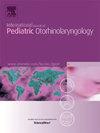Evaluation of safety and effectiveness of the LISTENT LCI-20PI cochlear implant in prelingually deafened children
IF 1.2
4区 医学
Q3 OTORHINOLARYNGOLOGY
International journal of pediatric otorhinolaryngology
Pub Date : 2024-09-15
DOI:10.1016/j.ijporl.2024.112109
引用次数: 0
Abstract
Objectives
This prospective multicenter clinical trial was to evaluate the safety and effectiveness of a novel cochlear implant (CI) system, the LISTENT LCI-20PI device in prelingually deafened children (<6 years old).
Design
The LCI-20PI CI system was implanted in 70 prelingually deafened children (<6 years old). The median age (interquartile range) at implantation was 3 years old (2–4 years old). The status of the LCI-20PI devices was evaluated through CI device testing and fitting including measurement of electrically evoked compound action potential (ECAP), electrode impedances, subjective thresholds (T levels), and subjective comfort levels (C levels). The safety and effectiveness of the devices were evaluated during 1-year follow-up. The clinical trial registration number is ChiCTR2200067092.
Results
ECAPs were successfully measured in 92.8% (64/70) recipients intraoperatively and in 94.3% (66/70) recipients during device activation. Most of the impedances (99.7%) were within normal limits of 0.7–20 kOhm. The median (interquartile ranges) Meaningful Auditory Integration Scale/Infant-Toddler Meaningful Auditory Integration Scale (MAIS/IT-MAIS) was 95% (85%–97.5%) at 12-month post-activation testing. Median (interquartile range) close-set monosyllabic-word recognition score (MRS) and disyllabic-word recognition score (DRS) in children 3–6 years old at 12-month post-activation testing were 86% (77%–97%) and 90% (70%–100%), respectively.
Conclusions
The new developed LCI-20PI CI device proved safe and effective in prelingually deafened children (<6 years old) in the clinical trial. This CI system could be a cost-effective alternative for prelingually deafened children.
评估 LISTENT LCI-20PI 人工耳蜗对语前聋儿童的安全性和有效性
目的这项前瞻性多中心临床试验旨在评估新型人工耳蜗(CI)系统 LISTENT LCI-20PI 装置在语前聋儿童(6 岁)中的安全性和有效性。设计为 70 名语前聋儿童(6 岁)植入了 LCI-20PI CI 系统。植入时的中位年龄(四分位数间距)为 3 岁(2-4 岁)。LCI-20PI 装置的状态通过 CI 装置测试和装配进行评估,包括测量电诱发复合动作电位 (ECAP)、电极阻抗、主观阈值(T 级)和主观舒适度(C 级)。在为期一年的随访中,对设备的安全性和有效性进行了评估。临床试验注册号为 ChiCTR2200067092。结果92.8%(64/70)的受试者在术中成功测量了电动电势,94.3%(66/70)的受试者在设备激活时成功测量了电动电势。大多数阻抗(99.7%)在 0.7-20 千欧的正常范围内。在激活后 12 个月的测试中,有意义听觉整合量表/婴幼儿有意义听觉整合量表(MAIS/IT-MAIS)的中位数(四分位数间距)为 95%(85%-97.5%)。在激活后 12 个月的测试中,3-6 岁儿童近集单音节词识别得分(MRS)和双音节词识别得分(DRS)的中位数(四分位数间距)分别为 86% (77%-97%) 和 90% (70%-100%)。对于舌前失聪儿童来说,这种 CI 系统是一种经济有效的选择。
本文章由计算机程序翻译,如有差异,请以英文原文为准。
求助全文
约1分钟内获得全文
求助全文
来源期刊
CiteScore
3.20
自引率
6.70%
发文量
276
审稿时长
62 days
期刊介绍:
The purpose of the International Journal of Pediatric Otorhinolaryngology is to concentrate and disseminate information concerning prevention, cure and care of otorhinolaryngological disorders in infants and children due to developmental, degenerative, infectious, neoplastic, traumatic, social, psychiatric and economic causes. The Journal provides a medium for clinical and basic contributions in all of the areas of pediatric otorhinolaryngology. This includes medical and surgical otology, bronchoesophagology, laryngology, rhinology, diseases of the head and neck, and disorders of communication, including voice, speech and language disorders.

 求助内容:
求助内容: 应助结果提醒方式:
应助结果提醒方式:


